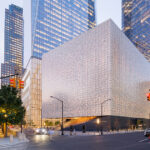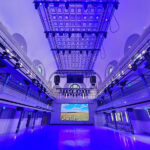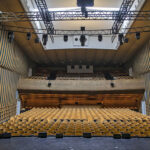Church balances modernization with historical integrity
Certainly any kind of installation work demands a high attention to detail, and everyone from architect to designer to installer to end user needs to be on the same page. The team that worked on the two-year renovation of the Salt Lake Tabernacle on Temple Square in Salt Lake City, Utah, took that pressure, doubled it and then doubled it again.
After all, these pros were working on a building that was originally opened in 1867 and has been at the center of The Church of Jesus Christ of Lat-ter-day Saints for 140 years, as well as the venue for the Mormon Tabernacle Choir’s weekly broadcast. Yet, this was not just any kind of renova-tion. “It was more than an install,” reports Lorin Morse, lighting designer and operator in the LDS Church Audio/Visual Department. “It was a gut-it and start over.”
Robert Breitenbeker, who serves as the manager of event support for all the venues on the Temple Square campus, concurs. “This is the first time the building has actually been closed and renovated any substantial amount,” he says. “So, this was our opportunity to completely redo all of the infrastructure — lighting, sound and A/V systems — to bring it into the current century.”
At the same time, the directive from church President Gordon B. Hinckley was to make sure that the essential structure was not altered. “The preservation people didn’t want anything to be changed, so we had to find an in-between medium,” Breitenbeker says. “We were ready to rip the ceil-ing down, put in catwalks, speaker positions and all of that stuff, but because of the very unique structure of the dome and its acoustic properties, we weren’t allowed to touch that. So we had to find other solutions. Having the building closed for a period of time [enabled us to] find solutions that fit all of the requirements, both on the preservation side and on the technological side.”
Before this opportunity, Breitenbeker admits with a laugh, almost every piece of lighting, projection and audio gear was bolted on. “It was always that we got a request, and we had to figure out a way to scab it on to the structure.”
Where to Put the Lights
In addition to improving the technology in the building, Breitenbeker says one of the goals was to make sure that the iconic image of the Tabernacle’s pipe organ remained pristine. “It’s sort of the trademark look of the Tabernacle Choir, so we tried to get all the technology out of the picture,” he says.
The first step in accomplishing this was moving all of the lighting positions, which were hanging from trusses in front of the organ, to the back of the room. “The lighting trusses used to be down in your face,” Morse says, “but now they are way back in the east end of the building, up as tight against the ceiling as they can get. So, when you walk in the room, the first things you see aren’t the trusses hanging in your face. It’s a lot cleaner look.”
Before the work was done, Morse recalls, there were seven trusses in the space. “I don’t know if you could even call them trusses,” he says. “They were old electrical control distribution strips that had a uni-strut channel on the top and bottom, with spring nuts so stuff could be bolted on. Every-thing traveled up and down live, so you could have things on that you didn’t have to go unplug and plug to focus things, but you still had to yo-yo focus.”
“With the new system,” he explains, “the trusses have an I-beam on the back chord on the bottom. We have a couple of focus baskets (I call them birdcages) that you hook on to those I-beams, and you trolley back and forth to do your focusing. For the most part, that works really well, but you still have a little bit of fine adjustment to do when you’re doing throws that are 70 or 100 feet long.”
Other than a handful of ETC Source Four fixtures that were recycled, the team installed all new fixtures for live performances in front of in-house audiences or for broadcast performances. The list of fixtures includes eight Vari*Lite VL3000Qs, 48 High End Systems Color Commands, 120 Ocean Optics SeaChangers, 18 ETC Source Four PARs, 145 ETC Source Four 5° and 10° fixtures, eight Wybron Nexeras, four ARRI 5kW Fresnels and a whopping 468 feet of Selador X7 LEDs used as cyc lights.
The cyc lights, Breitenbeker points out, are some of the more important new lighting pieces. “Because of the historic nature of the building, and because we’ve had some incidents in the past where fires have been caused by people throwing coats or other flammable materials on top of the cyc lights,” Breitenbeker says, “the decision was made that all of the cyc lighting is now LED. So, there is no heat issue, and consequently, there is no fire issue now. Yes, that was a very pricey solution to the problem, but because of the nature of the building, it was decided that it was well worth the expense.”
The Nexeras were put on articulating arms on the balcony to provide lighting from the balcony rail when needed, but are tucked away when not required. “That allows us to have the nice clean balcony look or, within about two minutes, you can have all of the lights deployed and ready to go for an orchestra concert,” Morse reports.
Who Controls the Lights?
One of the more interesting lighting features in the Tabernacle is that the organist, who plays in the venue just about every day, has the ability to control the lighting system. “There aren’t many 19th-century organ consoles running a lighting system,” Morse reports with a laugh. “The organ has five [keyboards], and underneath the keys are a series of thumb pistons. We went into the electronics in the organ and put in an A/B switch on the organ console where you push the A/B switch, and the function of eight of those thumb pistons becomes lighting control. They send a signal to Unison that fires a macro in Unison. We will fire it straight to the (ETC Eos) lighting console at some point, but it’s not ready yet. They haven’t gotten the software ready yet.”
Morse points out that the team continued with Eos because the ETC software is already embedded into the Tabernacle’s system, and they value the company’s customer service. “We’re familiar with their syntax for the most part,” he adds. “We have since changed to EOS, as has the Conference Center across the street. The biggest reason that we couldn’t go with Emphasis or something like that was the channel count. With all of the 130 SeaChangers, all having four channels apiece that are all individual, plus 468 feet of LED where every two feet is addressable seven times at seven different addresses per two feet — the channel count kind of goes through the roof in a hurry with all the multiparameter and multicolored fixtures and things.”
Beyond the daily organ recitals, Morse reports that the lighting work he does on the weekly 30-minute radio and television program, Music and the Spoken Word, is similar to what he did before the renovation. “We have SeaChangers on all of the choir wash lights,” he reports. “They are Source Four PARs, and all of the rostrum/orchestra lights are SeaChangers and Color Commands. We vary the colors to the music, or we leave it the same, depending on the conductor. We have a lot more functionality with color and that kind of thing, but as far as turning things on and off or on-air light changes, all of that has pretty much stayed the same.”
All of the lighting points and included electrics have been tucked away as much as possible to ensure that President Hinckley’s request be honored. “So, they are out of the picture essentially, and we maintained the historical integrity of the building,” says Morse.
Disappearing Projection Gear
The architectural and design teams went beyond lighting to honor that request, including the use of interesting projection features. Well, they al-most honored the entire request, but in order to get the video projection system to work, a pair of Christie Digital Roadster HD12K high-def DLP projectors was installed in the attic space of the domed ceiling. The two projectors are double-stacked via a crossfire pattern, and any issues from that arrangement were cleaned up using Christie Digital Twist image-warping and blending modules.
The pair of Vutec Retracta-Vu Pro screens are tucked neatly into custom built boxes that have been placed behind the last row of choir seats. The projectors are run by an Extron control system.
The system is used for both presentation graphics as well as video display with a 16:9 aspect ratio. There are three permanent camera positions in the Tabernacle (left, right and center), and there is a custom-designed camera track in the left and right balconies that is part of the balcony hand-rail, so that the camera does not intrude into the egress aisle for the balcony. Three Sony HDC1500L cameras are positioned at the permanent posi-tions, while two Sony HDC900s are stationed in the balcony.
The three permanent positions are controlled from a video control room in the Conference Center, which is about 1,300 feet from the Tabernacle. (Lighting control, though, is handled inside the building within a former crying room via an Eos system. Morse points out that there are actually three systems, one in use, one in a rack and a spare in the back of the room for emergencies in that control room.) Cameramen run the balcony cameras.
“Here again, because of the historic nature of the room, [the three permanent positions] all disappear when they are not in use,” Breitenbeker says. “What would be the left and right camera positions are actually mounted on pylons so that there’s a patch in the floor. They simply pop up at the end of one of the existing pews, do their job and when the broadcast is over, we can sync those back flush into the floor, and they go away.”
Since the Tabernacle reopened, it’s been a busy place, just like before the renovation. In fact, there are over 500 annual events in this historic venue and Morse, Breitenbeker and the rest of the lighting and projection team are putting the new system through its paces. So far, so good.


